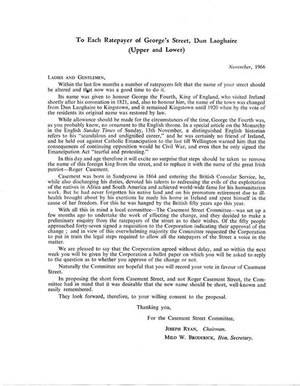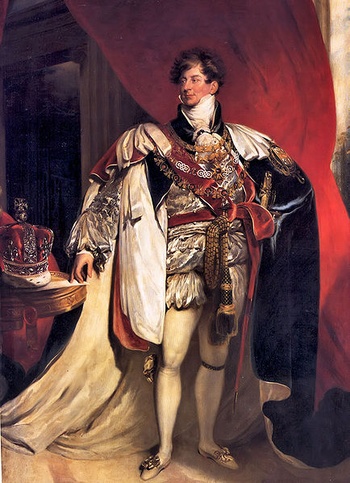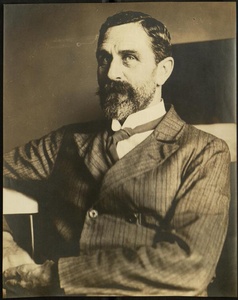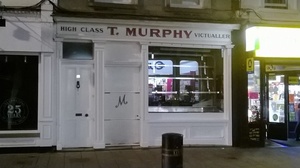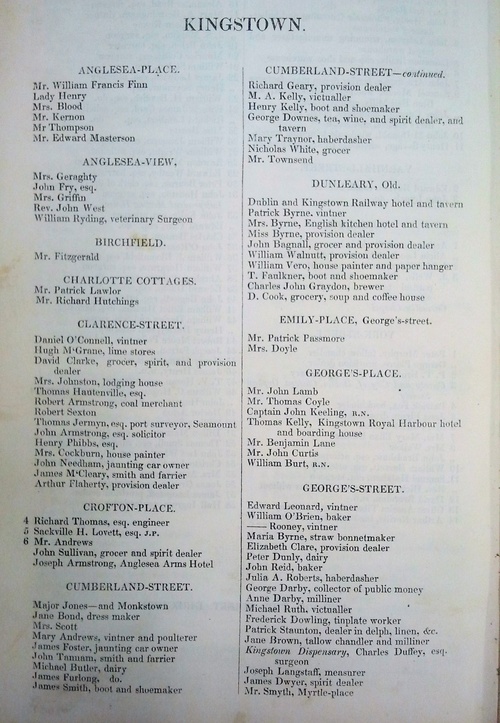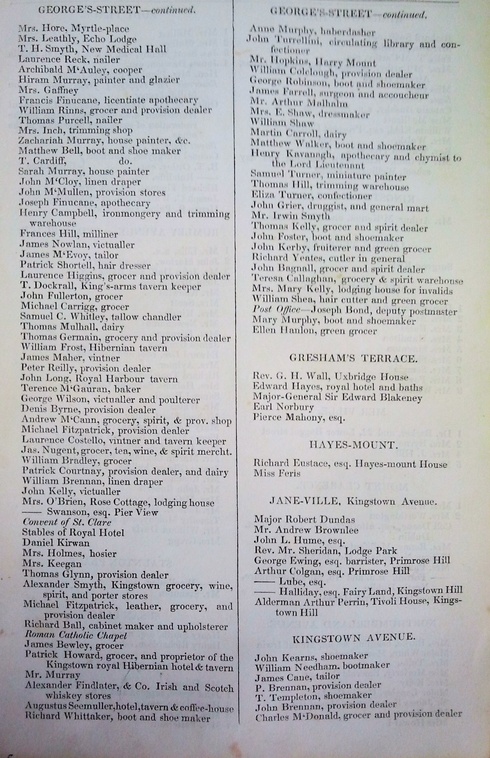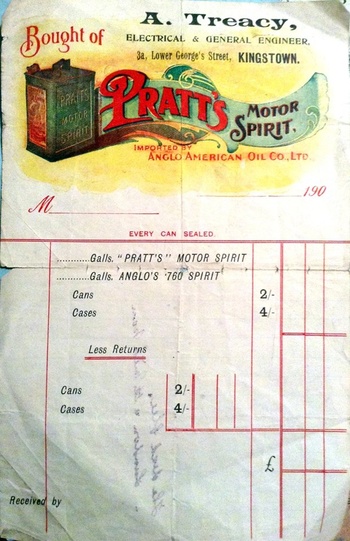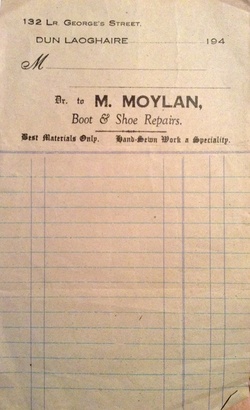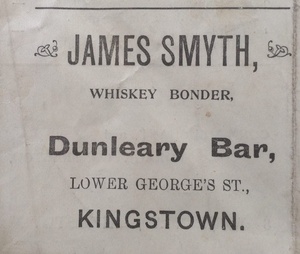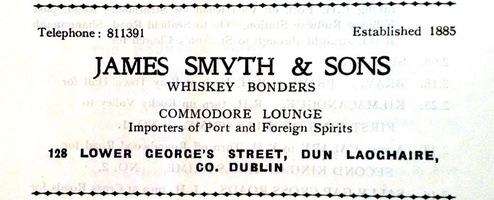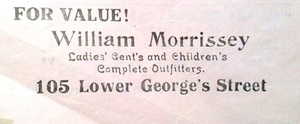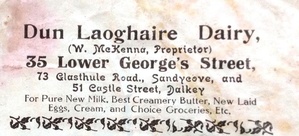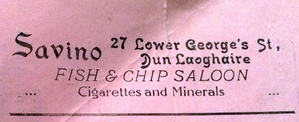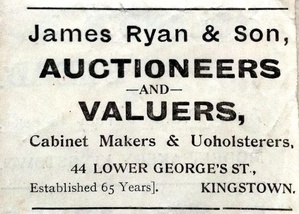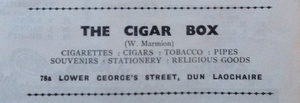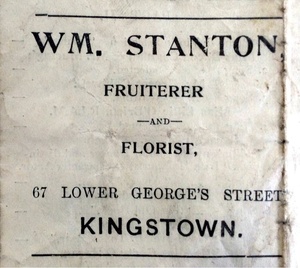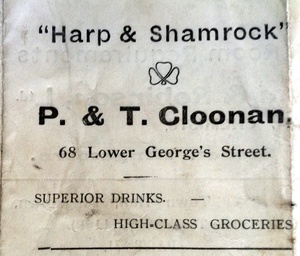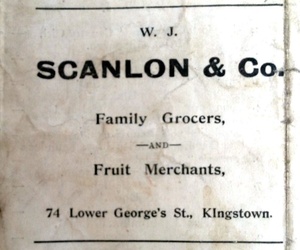Lower George's Street, Dun Laoghaire is the western half of the longest street in Dun Laoghaire, Ireland
The main part of the street runs north-west/south east, with a short hockey-stick bend at the north-west end.
It appears on various engineer's maps related to proposals for the harbour construction from about 1815, but the small hockey-stick piece of the western end of the street near York Road junction clearly existed before that date
History of the Street Name
The name George's Street (often shortened to George Street in historic photos) appears to have been applied to the whole length of the main street of the newly named Kingstown very soon after the visit of George IV (1762-1830) in 1821. The street had been laid out on a greenfield site at the time when plans for the harbour were drawn up about 1816.
Earlier maps show "The Three Churls" in the area now occupied by George's St. The Three Churls was an area of quarry and rock, and was mainly excavated to provide infill material during the construction of the harbour
Around the same time, a number of other streets in Dun Laoghaire were named after the brothers of George IV. These brothers were all dukes, respectively of Clarence (later King William IV), Sussex, Cumberland, York, Cambridge. Additionally, Adelaide Street was soon named after his sister-in-law, Adelaide, who became queen consort to William IV.
In 1838 the local Town Commissioners split the street into Upper and Lower George's St, and followed the Dublin convention that Lower is the part closest to the Liffey.
There were at least 3 unsuccessful attempts to change the name of the street.
- In 1902, there was a proposal to change it to O Growney St.
- In 1921, a name change to Moran St was proposed. Patrick Moran was hanged in 1921 for allegedly taking part in the killing of a British soldier.
- In 1966, a name change to Casement Street was proposed. Roger Casement (right below) was hanged in Britain for his part in gun-running in 1916. A copy of the letter sent to each ratepayer on the street is shown (above, right).
History of the street
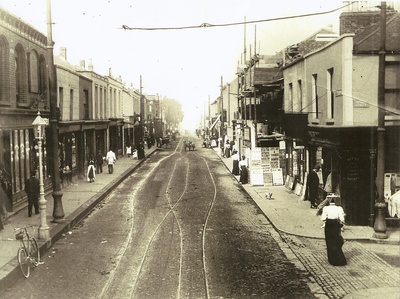 Lower Georges St at Sussex Street Corner about 1898. The tramlines were opened in 1896
Lower Georges St at Sussex Street Corner about 1898. The tramlines were opened in 1896
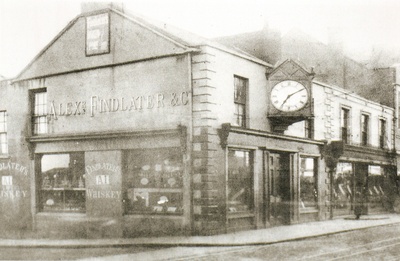 The picture above shows Findlaters at the corner of Lower Georges St/Sussex Street before the 1900 rebuild. Note the clock with two faces showing diagonally up and down the street
The picture above shows Findlaters at the corner of Lower Georges St/Sussex Street before the 1900 rebuild. Note the clock with two faces showing diagonally up and down the street
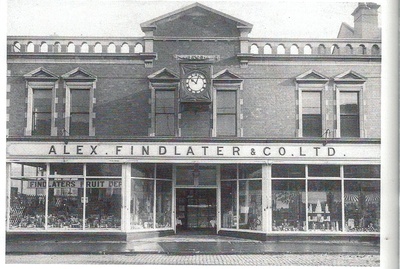 Findlaters after they had acquired McCullaghs next door and rebuilt both premises. Note that the clock now has 3 faces, following the opening of Convent road opposite. This picture is taken from Convent Road, from the spot where shops were demolished to open the street.George's Street was laid out as an unnamed street on a greenfield site at some time shortly before 1817, as plans for the development of the harbour were developed and it became clear that a significant town would develop in the area. The short curved piece of the street as it approaches Cumberland Street dates from an earlier period - the rest of the street is a perfect straight line
Findlaters after they had acquired McCullaghs next door and rebuilt both premises. Note that the clock now has 3 faces, following the opening of Convent road opposite. This picture is taken from Convent Road, from the spot where shops were demolished to open the street.George's Street was laid out as an unnamed street on a greenfield site at some time shortly before 1817, as plans for the development of the harbour were developed and it became clear that a significant town would develop in the area. The short curved piece of the street as it approaches Cumberland Street dates from an earlier period - the rest of the street is a perfect straight line
The street developed a full range of shops and trades very quickly, and by the time of the publication of the first directories and ordnance survey maps in the 1830s, it was a fully occupied street.
In the 1880s, tracks were laid for horse trams along the street, and these were replaced by electric trams from 1896
In the late years of the 19th century, many of the leases of the shops ran out. The landlords of the time, De Vesci, Pakenham and Longford insisted that street frontages should be redeveloped as a condition of the renewal of those leases, and these redevelopments shaped much of the street as we now see it.
Throughout much of it's history, Lower George's Street was a thriving bustling street, and the main shopping centre for the town and the surrounding areas. It had the full range of shops from the needles to the anchors (literally). It probably reached a peak in the first decades of the 20th century or thereabouts, in an age of some elegance in the area. By the 1970s, it was still a place where the shops did an excellent trade.
From the 1970s onwards, George's St went into gradual decline, and the decline was accellerated in the years of economic decline from 2007 onwards. The decline may be variously attriburted to:-
- The development of alternative shopping areas in the vacinity at Stillorgan, Cornelscourt, Blackrock, and more recently a major shopping development at Dundrum
- A lack of low-cost parking facilities, an essential for modern shopping
- A limited range of choice for customers in key sectors, including fashion items
- Inability to attract international brands
A further factor which may have hindered the development of the street is the lack of a positive and trusting relationship between the local authority, Dun Laoghaire/Rathdown County Council and the local business community in relation to issues such as parking, traffic, planning, and investment decisions.
The Development of the Streetscape of George's Street
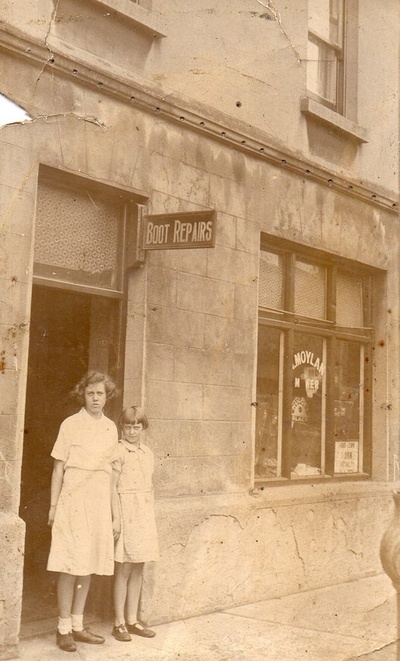 132 Lr George's St in the 1930s The oldest part of the street is the part close to the junction of York Road, and that part of the street was originally built before 1800. The picture (left) taken in 1948 shows that area. Number 1 George's St had a long list of changes of ownership over it's 200+ year history, and may have been remodeled at some point in it's history. This picture was taken from the shop diagonally opposite at number 132
132 Lr George's St in the 1930s The oldest part of the street is the part close to the junction of York Road, and that part of the street was originally built before 1800. The picture (left) taken in 1948 shows that area. Number 1 George's St had a long list of changes of ownership over it's 200+ year history, and may have been remodeled at some point in it's history. This picture was taken from the shop diagonally opposite at number 132
The picture can be dated by the fitting out of Byrnes shop at No 3a which is recorded in directories as 1948, and it is clear that the signwriter took a particular pride in his craft. The same cannot be said for the occupant (Stitch in Time) shown lower left in 1980. It can be seen that the shopfront has by then lost all of its characteristic shopfront ornamentation.
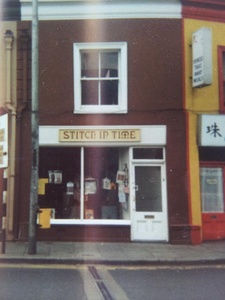 This picture (right) from the 1930s shows the shop of Moylans Bootmakers at number 132 and is one of a group of 7 houses which were clearly developed together. Maps before 1820 show that this was the earliest part of the street to be built - it is unlikely that these houses date from that time, but they are likely to date from before 1850, and many of the frontages of this group of houses are well preserved to date.
This picture (right) from the 1930s shows the shop of Moylans Bootmakers at number 132 and is one of a group of 7 houses which were clearly developed together. Maps before 1820 show that this was the earliest part of the street to be built - it is unlikely that these houses date from that time, but they are likely to date from before 1850, and many of the frontages of this group of houses are well preserved to date.
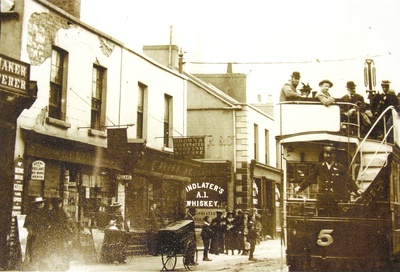 87, 86, and 85 Lower George's Street about 1900In 1820, much of the street was sparsly populated by buildings. Over the subsequent 30 years there was very rapid development so that by 1850 the street had a full frontage on both sides of the street, with a range of shops. The early shops built upon Lr George's St were basic and functional, and little of them remains even as photographs. Where such photos exist, it is difficult to place them in context, and to recognise the precise location.
87, 86, and 85 Lower George's Street about 1900In 1820, much of the street was sparsly populated by buildings. Over the subsequent 30 years there was very rapid development so that by 1850 the street had a full frontage on both sides of the street, with a range of shops. The early shops built upon Lr George's St were basic and functional, and little of them remains even as photographs. Where such photos exist, it is difficult to place them in context, and to recognise the precise location.
This photo (below left) dated about 1898 shows, from left, Numbers 87, 86, and 85, and judging from the appearance of Number 87 in particular, the buildings are quite old at the time, and clearly belong to the early phase of development of the street. Throughout most of the 20th century, these were the premises of Dixon's newsagents (87) and Sir Thomas Brown tobacconist (86), and the upper levels of these two buildings have been preserved to the present day. A small number of buildings of equally basic design remain on the street.
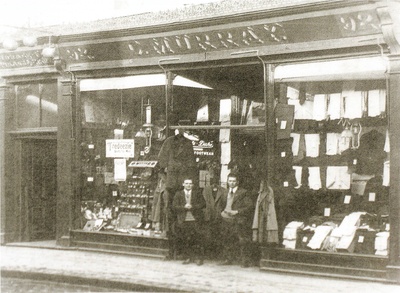 No 92, Murrays Pawn Shop about 1920
No 92, Murrays Pawn Shop about 1920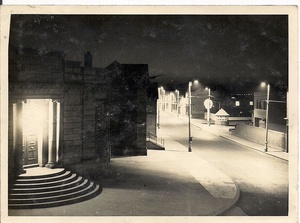 Dun Laoghaire had a major public health problem throughout the 19th century, mainly due to insanitary housing and poverty. Poverty and wealth lived alongside each other. Lively trade and major unemployment were bedfellows and these contrasts were well represented along Lower George's St. Many of the fine houses and business premises had backyards, called courts behind them, and these were occupied by multiple families living in little better than sheds. The very fine Carnegie Library was built in 1912, but to create that, and also to create Library Road, a number of houses and the courts behind them were removed. These included Duff's Court, Ball's Court, and Flynn's Court. In the 1901 census, Ball's Court had 22 souls in 5 households. In Flynn's Court there were 7 people in 2 households. 49 people lived in Duff's Court.
Dun Laoghaire had a major public health problem throughout the 19th century, mainly due to insanitary housing and poverty. Poverty and wealth lived alongside each other. Lively trade and major unemployment were bedfellows and these contrasts were well represented along Lower George's St. Many of the fine houses and business premises had backyards, called courts behind them, and these were occupied by multiple families living in little better than sheds. The very fine Carnegie Library was built in 1912, but to create that, and also to create Library Road, a number of houses and the courts behind them were removed. These included Duff's Court, Ball's Court, and Flynn's Court. In the 1901 census, Ball's Court had 22 souls in 5 households. In Flynn's Court there were 7 people in 2 households. 49 people lived in Duff's Court.
 Number 92 - ready for sale 2012 - had been McManus for many yearsWhen this picture of the library (left) was taken about 1956, the Workman's Club beside it was still active. Smyth's pub can be seen in the background and Archers Garage (Costal Motors Ltd) was in operation. The circular building in front of the garage was a cabin for the cashier. Those were law-abiding times when a cashier could be located in such a low-security manner.
Number 92 - ready for sale 2012 - had been McManus for many yearsWhen this picture of the library (left) was taken about 1956, the Workman's Club beside it was still active. Smyth's pub can be seen in the background and Archers Garage (Costal Motors Ltd) was in operation. The circular building in front of the garage was a cabin for the cashier. Those were law-abiding times when a cashier could be located in such a low-security manner.
Shop frontages of the type shown right (No. 92, Murray's Pawn Shop about 1920) were very typical of the period for any street in Ireland. The frontage has been largely preserved as shown in the lower picture. Since the date of the 2012 photo, the new occupier, a discount shop, has preserved the frontage, but has painted it white. New signage over the door does look a bit out of place for a building of this type.
Murphy's High-class Victualler at number 46 (left) is another example of traditional Irish shopfront and has remained largely unchanged since victorian days. This shop was a hairdresser shop 100 years ago, operated by a Mr J Pepper, but became a butchers shop in the 1930s and has remained so.
.
.
.
.
.
.
.
Early Directories of Lower Georges St
1 The Dublin Almanac (1835) Pettigrew & Oulton
This directory dates from the period when Upper and Lower Georges St were one street. Unfortunately, no numbering is shown. The "Roman Catholic Church is shown about 2/3rds way down the street
Shops on Lower George's Street - Part 1 - York road Junction to Library Road
Treacy's operated an electrical & General Engineering business at no 3a Lr George's St in the early years of the 20th century. They also sold petrol, as shown in the receipt opposite. Clearly, the receipt form is provided by Pratts, who in turn purchased of Anglo American (Anglo American later became part of the Esso group of companies. Clearly, the petrol was sold in returnable cans and cases, with "every can sealed", and a deposit of 2/- (two shillings) for each can and 4/- for each case.
Moylan's was a family bootmaking business operating at number 132 Lr George's St from the 1920's through to the 1980s, and the billhead above dates from the 1940s. Paddy Cullen is seen in the photo above in the process of making or repairing a shoe. Moylan's shop at 132 Lr George's St is shown further up this page.
 Smyth's Pub has served liquor from 1885 through until about 2008 when it was renamed as Gilbert & Wright's, one of a small chain of suburban pubs around Dublin
Smyth's Pub has served liquor from 1885 through until about 2008 when it was renamed as Gilbert & Wright's, one of a small chain of suburban pubs around Dublin
The picture (right) shows Smyth's Pub, which was rebuilt in the 1920s
The man standing in front of the pub is Johnny Shortall, a well-known Dun Laoghaire character who was later murdered in a robbery at the Dun Laoghaire Motor Yacht Club
This advertisment for Smyth's pub shows no phone number and dates from the early 1900s
The advertisement below is probably from the 1970s or thereabouts and shows a 6-digit phone number
.
.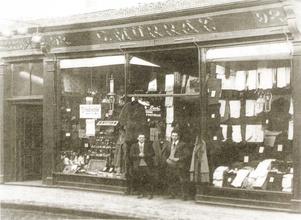 Murrays, 92 Lr George's St combined pawnbroking with a shop selling clothing, shoes and jewellery. This shop is now a €2 discount shop. The overall shape of the frontage has been well retained.
Murrays, 92 Lr George's St combined pawnbroking with a shop selling clothing, shoes and jewellery. This shop is now a €2 discount shop. The overall shape of the frontage has been well retained.
.
 No. 92 in 2012 .
No. 92 in 2012 .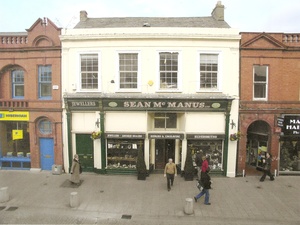 McManus's
McManus's  In the later 1920s, Number 92, Lower Georges St was sold by the Murray Brothers to Patrick McManus, and the shop remained in the possession of the McManus family until 2013. The above advertisement is from 1930
In the later 1920s, Number 92, Lower Georges St was sold by the Murray Brothers to Patrick McManus, and the shop remained in the possession of the McManus family until 2013. The above advertisement is from 1930
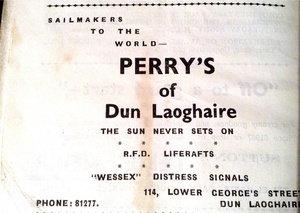 Add a caption
Add a caption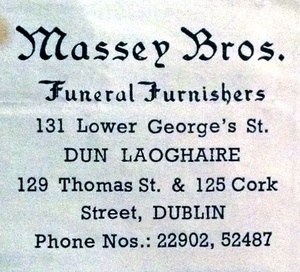 Add a caption
Add a caption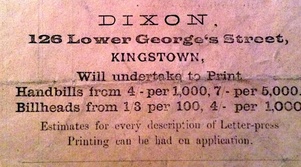 Add a caption
Add a caption This 1893 advertisement is interesting in it's style and layout. So many typestyles and fonts. So many useful services..
This 1893 advertisement is interesting in it's style and layout. So many typestyles and fonts. So many useful services..
.
Shops on Lower George's Street - Part 2 - Library Road to Bloomfields (no 24-37 & 105-116)
.
Shops on Lower George's Street - Part 3 - Bloomfields to Convent Road (41-64 & 86-98)
.No 41 is Tom Dunphy's
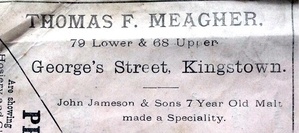

 .
.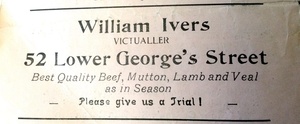
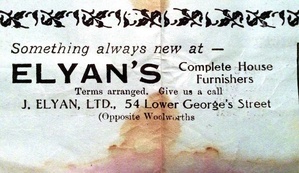 1936
1936 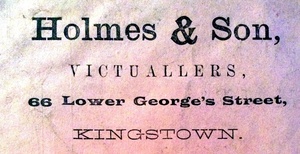 This is one of the shops on Lower Georges St that was demolished and removed to create Convent Road. The advertisement dates from the early 1890s
This is one of the shops on Lower Georges St that was demolished and removed to create Convent Road. The advertisement dates from the early 1890s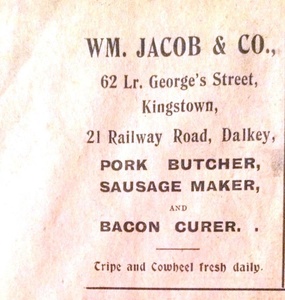 Note Tripe and Cowheel
Note Tripe and Cowheel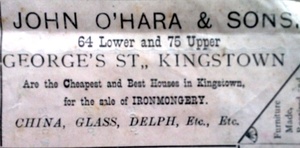
.
.
.
Shops on Lower George's Street - Part 4 - Convent Road to Patrick Street (67-77 & 78-85)
.
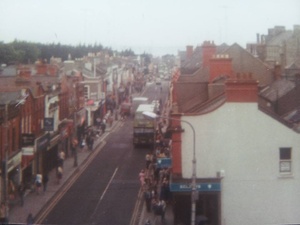 Add a captionTwo way traffic taken approximately 1980
Add a captionTwo way traffic taken approximately 1980

